Table of Contents:
- Previous Rideshare Viability Estimates in the Literature
- Overview of MIT
- Methodology & Approach to Estimating Rideshare Viability at MIT
- Rideshare Viability at MIT
- Modeled Potential vs. Observed Rideshare Behavior
- Rideshare Model Shortcomings
- Final Observations
Previous Rideshare Viability Estimates in the Literature
Last modified on 2010-08-31 15:37:54 GMT.
There is relatively little in the recent literature that has attempted to quantify the benefits of ridesharing, and even fewer resources that have proposed a comprehensive methodology of doing so. Given the rather substantial amount of personal information required to determine rideshare viability, it is conceivable that institutions or organizations have conducted these types of analyses but have kept the results private.
Research and consulting reports have been one source for quantified rideshare potential. One early attempt was a 1994 report summarizing the effectiveness of transportation control measures (TCMs) from various state-level trip reduction programs (Apogee Research, 1994). The report found that the provision of rideshare benefits at a regional level could eliminate up to 2% of VMT and 1% of trips. More recently, a report titled Moving Cooler estimated the GHG reduction potential from a wide range of transportation strategies, implemented individually and as bundles (Cambridge Systematics, 2009). For the strategy labeled “Employer-Based Commute Strategies” (of which ridesharing is a component), a logit mode choice model (named COMMUTER) was used to estimate mode shifts and the resulting change in emissions. The COMMUTER model uses aggregate mode choice data for different ‘classes’ of metropolitan area. Emission reductions from baseline were estimated at 0.4 – 2.0% depending on the level of effort employed. The Growing Cooler results require some cautious interpretation; as one might expect, ‘employer-based commute strategies’ includes far more than ridesharing. In fact, this strategy includes provisions for ridesharing, a transit subsidy, modifications in parking policies, a compressed workweek provision and telecommuting. If ridesharing alone is isolated from this bundle, emission reductions from baseline are towards the lower end of the scale (approximately 0.4%).
Academia has also attempted to measure the potential market for ridesharing. A study by Tsao & Lin (1999) is one of the more comprehensive attempts to measure the potential of ridesharing based on spatial and temporal factors. Unfortunately, the study made several simplifying assumptions that greatly underestimate the potential of ridesharing, and likely led the authors to conclude that the benefits were too small to quantify. The study presented a hypothetical metropolitan area with a uniform density of jobs and workers across the entire area. This assumption, while simplifying the author’s model specification, conflicts substantially with observed metropolitan spatial distribution of jobs and housing. In reality, metropolitan areas have substantially varied commercial and residential densities. Higher densities of either commercial or residential activity, and more specifically, the variability of high densities across a geographic area is a major determinant of commuting patterns and increases the likelihood of finding a rideshare match. The authors also assumed that participants would only consider sharing a ride if they lived in the same two-mile by two-mile square area. While some recent research (Buliung, 2010) suggests that rideshare matching at the residential end of a trip is a strong determinant of rideshare potential, Tsao and Lin’s assumption effectively eliminates the ability to match riders and passengers based on the route they travel, thereby underestimating the number of potential riders. While the methodology was meant to look at rideshare potential in a hypothetical metropolitan area, it is important to note that both of the author’s simplifying assumptions lead to an underestimation of rideshare potential.
An analysis conducted by students at the University of Toronto (Sarraino et al., 2008) attempted to measure the number of staff, faculty and students that could rideshare to the St. George campus (downtown Toronto), based on data provided by the university administration. The study used a GIS approach to identify common clusters of commuters that were traveling to campus. It was assumed that shared rides would only occur between drivers and passengers living within a 3 km radius of one and other. This residential proximity assumption is similar to the one used by Tsao and Lin, and could limit some mid-trip pairings. Commuters were only considered as matches if they were leaving their residence within the same 30-minute period. Unfortunately, due to data limitations, only AM residential departure times were available, making any assessment of return trip (or roundtrip) rideshare viability impossible. The analysis found that during morning commute hours (7:00 – 10:30am), 1,461 of 3,030 drive trips (48%) were suitable for ridesharing based on residential proximity and similar residential departure times. Had roundtrip matching been possible, the expected match rate would be lower.
Overview of MIT
Last modified on 2010-08-31 15:49:03 GMT.
MIT’s main campus is located in Cambridge, MA directly across the Charles River from Boston, MA. The Institute is home to approximately 22,000 faculty, staff and students, of which approximately 18,000 are employed or study on the main campus in Cambridge (~8,000 faculty and staff, ~10,000 students). MIT is well served by transit with access to the Massachusetts Bay Transportation Authority’s (MBTA) Red Line at Kendall Square, two limited-stop bus services (the CT1 on Massachusetts Ave. & the CT2 on Vassar St.), and five regularly scheduled bus services (the #1, #64, #68, #70 & #85). Access to the MBTA commuter rail system is possible via the Red Line at South Station and at Porter Square Station, and via the MIT-supported E-Z Ride bus shuttle with service to North Station. MIT owns approximately 4,000 parking spaces and leases an additional 500 spaces.
The high level of transit service and MIT’s location in relatively dense Cambridge, MA are two reasons that the use of transit and non-motorized transport are higher than in other parts of the Boston metropolitan area and much higher than the US average. The table below summarizes mode choice for staff and faculty at MIT, in Cambridge, MA, in the Boston Metropolitan Statistical Area (MSA) and across the US.
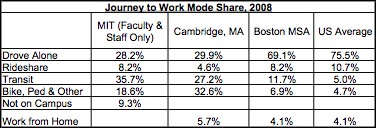
The impetuses for further exploration of rideshare opportunities at MIT are numerous. First, parking on campus is becoming an expensive challenge for the Institute. The 500 leased parking spaces costs the Institute approximately $1.5M. a year in fees and in recent years, the Institute has begun constructing underground, structured parking at an estimated cost of $125,000 per space (Block-Schachter, 2009). Rideshare promotional efforts may be able to reduce the need for expensive parking construction and leasing. Second, the State of Massachusetts has begun a long-term project to rehabilitate a number of the bridges between Boston and Cambridge across the Charles River. Two of the bridges slated for closure and reconstruction, the Longfellow Bridge and the BU Bridge, are both in close proximity to MIT and will limit vehicle access to campus during the reconstruction phase. Ridesharing could be one important mitigation measure to ensure that an acceptable level of mobility is maintained in the southern part of Cambridge during the reconstruction process. Third, the Institute has made a commitment through the MIT Energy Initiative to ‘Walk the Talk’ and identify areas where energy consumption on campus can be reduced. Vehicle travel to and from campus is not an inconsequential portion of MIT’s energy footprint; two separate student theses have estimated contributions of 4 to 14% of Institute-wide energy consumption coming from private vehicle travel (Block-Schachter, 2009)(Groode, 2004). Ridesharing has the ability to provide additional transport options to the MIT community while helping the Institute ‘Walk the Talk’ on energy efficiency.
Methodology & Approach to Estimating Rideshare Viability at MIT
Last modified on 2010-08-31 16:04:55 GMT.
A four step analytical approach was undertaken to estimate ridesharing potential at MIT: (1) MIT commuter survey preparation, (2) spatial analysis of commuter trips, (3) application of realistic trip characteristic filters, and (4) selection of feasible pairings.
Several important assumptions have been made during this analysis.
First, this approach assumes that only two-person carpools are possible. This assumption was made to simplify the matching process, however it is not believed to significantly affect the results. The complexity of identifying a third or fourth rideshare participant with a similar schedule and the additional travel time burden of picking up another passenger is likely to limit the number of feasible rideshares with three or more people.
Second, the approach assumes that a driver is willing to deviate from their normal route to MIT to pickup a passenger at their residential location. The prospect of drivers and passengers meeting at a mutually beneficial intermediate destination was not considered. Once again, this assumption was made to simplify the matching process.
Third, it was assumed that when a driver deviates to pickup a passenger, the pickup time is zero. This assumption is certainly unrealistic and understates the commitment the driver is being asked to make. Even in instances where the passenger is prompt there is likely to be some perceived, or psychological, wait time experienced by the driver.
Fourth, the chaining of trips to and from campus were ignored. No information on trip chaining behavior was available in the survey.
Step 1 – MIT Commuter Survey Preparation
MIT undertakes a comprehensive commuter survey every two years to measure commuter preferences and changes in commuting over time. The survey is administered to most of the MIT community and includes responses from undergraduates, graduate students, faculty, academic staff and support staff. The City of Cambridge and the Commonwealth of Massachusetts require that the survey be conducted. For this analysis, the 2008 version of the survey was used.
In 2008, MIT had approximately 21,800 community members including faculty, research staff, support staff, graduate students and undergraduate students. Of the full community, approximately 16,600 on-campus members were invited to complete the survey. Of the 5,200 that were not invited, over half were MIT staff working at the Lincoln Labs facility in Lexington, MA, approximately 15 miles NW of the main Cambridge campus. Approximately 10,300 community members completed the survey, representing a response rate of 62%. Completed survey responses were further filtered to isolate only community members that (a) commute to MIT’s main campus for work, (b) live off-campus, (c) are either faculty or staff (students were eliminated from this analysis), and (d) had a residential address that could be properly geo-coded into a Latitude-Longitude value. Requirements (a) and (b) ensure that a commuting trip is taking place. Graduate and undergraduate students were eliminated from this analysis for several reasons. Undergraduates at MIT are required to live on-campus, or in Institute-sponsored, off-campus housing such as fraternities or sororities. The off-campus, undergraduate housing options are well served by the MIT-operated campus shuttle bus system. It was assumed that undergraduates would rarely, if ever, require a rideshare arrangement to travel to campus. Graduate students were eliminated because of the assumed variability of their daily schedules. The survey does ask for a community member’s arrival time on campus and departure time from campus, but only “on a typical day”. For graduate students, it was believed that responses to that question would be highly variable day to day and would reduce the value of the analysis. Further, graduate students have a much different pattern of residential selection than staff and faculty do. Students tend to live closer to campus, reducing their likelihood of choosing ridesharing as a mode of travel.
Two groups of commuters were identified for use in the feasibility analysis; (1) all commuters regardless of their mode of travel (labeled “All Modes”), and (2) those commuters that traveled to campus as a single occupant driver four or five times during the previous work week (labeled “Primarily SOV”). Note that the “Primarily SOV” group is a subset of the “All Modes” group. While portions of the “All Modes” group already commute using sustainable forms of transportation, they were included in the analysis to see what percentage of the MIT community could successfully be matched and could possibly participate in ridesharing. The “Primarily SOV” subset is the group of greater interest, as they are the ones whose potential travel behavior change would have the greatest impact on reducing VMT and reducing the need for on-campus parking.

Step 2 – Spatial Analysis of Commuter Trips
With 5,061 completed surveys by the targeted groups, including geo-coded residential locations, a spatial analysis of commuting trips to MIT was undertaken. A transportation network model of the greater Boston area developed in a previous academic course was used in conjunction with the TransCAD transportation modeling software package. The road network within the Boston model includes a value for congested travel time on every road link in the network, as calculated by an iterative traffic assignment process undertaken during a previous 4-step transport-modeling endeavor. Whereas the University of Toronto approach looked for clusters of commuters at the residential end using a GIS-buffer approach, this approach capitalizes on the availability of a congested road network that allows for the use of a least-cost travel time algorithm to assign commuters to a path they would most likely choose to get to MIT, if were seeking to minimize their travel time. In clearer terms, while the University of Toronto approach made matches based on residential proximity only, the proposed approach makes matches based on a route that commuters are likely to choose. The added benefit of this approach is that it allows for the matching of drivers and passengers mid-trip, along the driver’s path.
The 5,061 geo-coded commuter records were imported into TransCAD as a series of points. One additional point representing the main entrance to the MIT campus at 77 Massachusetts Avenue was added to the list. The commuter points were linked to the nearest roadway intersection on the network using a spatial join. A road network skim of travel time and travel distance was performed from all commuter points to all other commuter points. Since this procedure was essentially taking the travel time and distance from all 5,062 points to all other 5,062 points, it generated a database table with 25.6M. commuter pairings (5,062 x 5,062), many of which have real potential for ridesharing and some of which are not at all feasible. The third step, applying trip characteristic filters, is where only those rideshare pairings that are feasible are identified.
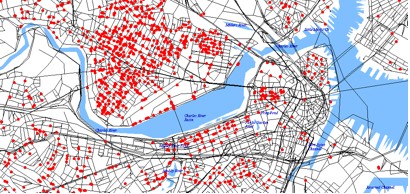
Step3 – Application of Trip Characteristic Filters
The third step involved filtering the millions of commuter pairings generated in TransCAD down to only those that could be reasonably expected to share rides. With the table of 25.6M. records, one must first determine the direct distance and travel time to MIT for all 5,061 commuters. Since MIT’s location was coded as one of the records, a process of extracting a subset of the existing data table (those pairings where the MIT node was the destination) was used. One can think of these as the SOV distances and travel times for a driver and passenger in a potential rideshare arrangement, if they both chose to drive to campus alone. In the rideshare diagram shown below, these are the segments labeled ‘DirectD’ and ‘DirectP’ for commuters #1 and #2 respectively. The next step involved calculating the carpool distance and travel time. Carpool values were assumed to be the distance/time from the ‘driver’s’ residence to the ‘passenger’s’ residence (the segment labeled ‘Leg1’), plus the distance/time from the ‘passenger’s’ residence to MIT (the segment ‘DirectP’). At this step in the analysis, no restrictions were placed on rideshare roles, so commuters could be identified as drivers or passengers. The difference in values between the ‘driver’s’ direct trip to MIT (‘DirectD’) and the carpool distance/time (‘Leg1’ plus ‘DirectP’) is a particularly important trip characteristic filter that will be described later in this section.
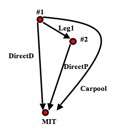
A series of filters were applied to isolate only those commuter pairings that were believed to be feasible for ridesharing. The following list outlines the filters used and the rationale for applying them.
(a) The ‘driver’ is only willing to accept a deviation of five minutes (5 minutes) or less from their normal drive-alone travel time. This was the difference between the ‘DirectD’ segment travel time and the calculated carpool travel time outlined previously. A five-minute threshold was chosen based on previous rideshare survey findings. Li et al. (2007) found that 75% of 2-person carpools in Texas involved a deviation of five minutes or less. Attanucci (1974) previously found that 51% of members of the MIT community were willing to deviate no more than five minutes and an additional 29% were willing to deviate between five and ten minutes. Note that this filter does not restrict the direction of travel. If a passenger is two minutes in the opposite direction from the driver’s residence (and thereby adds a total of four minutes to the driver’s journey), the filter suggests that that trip is as likely to occur as one that requires a four minute deviation off of the driver’s main route to MIT. While this is assumed not to be a substantial burden on drivers it could very well be. As such, sensitivity analyses were also performed at 2 minute and 10 minute deviation thresholds.
(b) The ‘driver’ is unwilling to spend more than 150% of his/her drive-alone travel time to rideshare to campus. This filter only affects those that are already relatively close to MIT. For example, if a driver normally has an eight-minute commute to campus, this filter will limit the feasible set of passengers to those that add four minutes or less to the driver’s journey. For commutes longer than 10 minutes, the “five-minute deviation threshold” filter described above supersedes this filter. As such, this filter eliminates relatively few pairings, but pairings that are quite unlikely to represent desirable rideshare arrangements.
(c) ‘Passengers’ within 1 mile of campus are excluded from consideration. Within a distance of 1 mile, the attractiveness of walking, cycling and transit should be much higher than the attractiveness of ridesharing.
(d) The ‘driver’ in the rideshare arrangement must have access to a vehicle. The 2008 MIT Commuter survey asks respondents whether they have access to a private vehicle for daily commuting.
(e) The ‘driver’ and ‘passenger’ in a rideshare arrangement must arrive on campus and depart from campus within the same 30-minute period. The 2008 survey asks participants to provide their arrival/departure time to/from campus on “a typical day”. Respondents are provided with 30-minute blocks of time (7:00-7:29am, 5:30-5:59pm, etc.) and are asked to choose only one block. The implication of having both arrival and departure times matching for both the ‘driver’ and ‘passenger’ is that roundtrip, rideshare opportunities are assumed.
Step 4 – Selection of Feasible Pairings
At this point, those commuter pairings that are believed to be feasible have been identified. However, there are often cases where a driver has the option of picking up multiple passengers, or passengers can be matched up with multiple drivers. Adding to the complexity, there is nothing stopping a commuter from being a driver in one pairing and a passenger in another pairing. Since the assumption is that only two people can share a ride at any given time, this step requires the specification of a decision variable to select ‘feasible’ pairings, such that no commuter (driver or passenger) is paired up more than once on any given day. In more general terms, one can think of the output of Step 3 as the full list of feasible pairings that are possible over the course of a week or month, whereas the purpose of Step 4 is to select only those pairings that are possible on any single day. This final step is essentially seeking to maximize the number of members of the MIT community that can be paired together by employing an optimization process.
Two approaches were used to identify ‘feasible’ pairings; one approach used the CPLEX algorithm in the OPL Studio software suite, and the second option involved a simple heuristic approach using a standard spreadsheet program. The CPLEX approach involved solving a general network flow problem with side constraints to ensure that a commuter was not paired up as both a driver and a passenger in separate pairings. For the “All Modes” subset of commuters, the objective function used was the maximization of commuter pairs. For the “Primarily SOV” subset, the objective function used was the maximization of VMT savings.
The heuristic approach began by sorting the list of pairings from highest to lowest potential VMT savings, and then employed an iterative approach of selecting drivers and passengers. The first driver-passenger pair with the largest VMT savings was “activated”, and both commuters were removed from consideration in all further pairings. Moving onto the next pairing, both the driver and passenger were checked to see if they were “available” for matching. If either the driver or passenger were previously “activated”, the selected pairing was discarded and the next pair was considered. This process was repeated for all pairings in the list. The decision variable for both subsets of commuters (“All Modes” and “Primarily SOV”) is the maximization of commuter pairs, but implicitly VMT savings are also considered given the initial sorting that took place.
The two approaches have different strengths and weaknesses. The CPLEX optimization approach provides an outcome that is more robust, but requires writing the problem statement in the proprietary language of the software, which is relatively time consuming. The heuristic approach is quite simple to implement in commonly available spreadsheet programs, is not particularly time consuming, but provides a sub-optimal set of feasible pairings. Whereas the heuristic approach may select a single driver-passenger pair that has relatively high VMT savings, the CPLEX approach may identify two pairings, each with relatively smaller VMT savings, but where the total savings from both pairings are larger than the single, high VMT pairing. For this analysis, both the CPLEX and heuristic results will be reported.
Rideshare Viability at MIT
Last modified on 2010-08-31 16:11:23 GMT.
Figure #3 summarizes the results from the analysis of rideshare potential among members of the MIT community. The results for the “All Modes” subset of commuters are on the left side of the figures and the “Primarily SOV” subset on the right side. The number of feasible pairings and the number of pairings possible on a single day are reported, along with the associated percentages of the total commuter population evaluated. For the “Primarily SOV” subset, the daily VMT savings achievable from ridesharing are also provided.
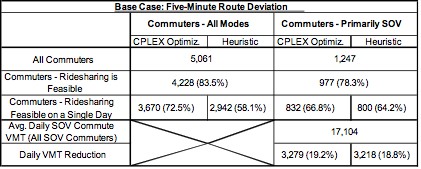
There are a number of important insights that follow from this analysis. To begin, the percentage of the MIT community that can feasibly share rides is very high. Depending on the driver deviation assumptions, between 70% and 88% of the surveyed MIT community has the option of engaging in ridesharing. For those whose primary mode of commuting is SOV travel, approximately 49% to 92% could rideshare if they chose to do so, again depending on the driver deviation assumptions. For the “All Modes” group of commuters, 83% of drivers would have to deviate less than two (2) miles.
On a daily basis, approximately 50% to 77% of the MIT Community could rideshare depending on the model assumptions. This is substantially higher than the current share of the community that chooses to rideshare (8.2%). In terms of VMT reduction potential, the model suggests that 9% to 27% of daily, commuter-based VMT could be reduced through choosing to rideshare, with a ‘base-case’ estimate of a 19% daily reduction in VMT.
Finally, from a methodological standpoint, it is interesting to consider the difference between the CPLEX optimization and simple heuristic approaches to identifying the feasible rideshare pairs on a single day. In terms of the maximization of pairings, one can clearly see that larger datasets favor the optimization approach. For smaller datasets, the difference between the two approaches is less pronounced. For the determination of VMT savings, the two approaches yield remarkably similar results.
Modeled Potential vs. Observed Rideshare Behavior
Last modified on 2010-08-31 16:17:35 GMT.
While the aggregate results of rideshare potential at MIT are interesting, the comparison of the modeled results against the observed travel behavior of the MIT community is perhaps more interesting. The matrix shown below compares the modeled and observed travel behavior for the 5,061 commuters considered in the ‘base case’ (five minute deviation) analysis. Along the left side, community members are identified by their modeled rideshare feasibility. Along the top, they are identified by whether they engaged in any form or ridesharing (carpool or vanpool) at least once during the previous workweek. The “All Modes” group of commuters was used rather than the “Primarily SOV” subset because the analysis is attempting to compare modeled rideshare behavior to observed commuter rideshare behavior, regardless of whether or not these commuters are the ones that would be targeted for an MIT community-based rideshare initiative. If the analysis was limited to the “Primarily SOV” subset, it would be attempting to compare modeled and observed rideshare behavior for a subset that was selected specifically because they do not currently rideshare, largely defeating the purpose of the analysis. However, it would be false to state that 3,615 commuters should be targeted in a rideshare initiative. This group includes community members that already use sustainable modes of travel to get to MIT; they walk, cycle or take transit. From a policy standpoint, the 946 frequent SOV drivers should be the primary targets for increased rideshare participation.
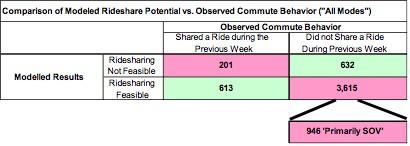
At first glance, the 201 community members that shared a ride when the model suggests they should not have (top-left quadrant) is concerning as it suggests deficiencies or missing variables in the model. Two possible explanations for this include (a) filters that were too restrictive, and/or (b) the influence of unobserved human preferences, particularly the incidence of ridesharing with family members not affiliated with MIT. It is possible that the filters applied were too restrictive in identifying those commuters most likely to rideshare. A more likely explanation is that some of the rideshare trips undertaken were with family members where at least one member of the rideshare was not affiliated with MIT, and therefore did not complete the survey. Previous research has found that between 25% and 80% of ridesharing trips are intra-household, or between family members, so it seems possible that at least some of these shared rides are family based. Unfortunately, the MIT Commuter Survey does not ask respondents to indicate with whom they shared a ride.
Rideshare Model Shortcomings
Last modified on 2010-08-31 16:19:35 GMT.
Even though the MIT Commute Survey contains very detailed information on travel habits, many of the drawbacks of this modeling effort actually relate to a lack of detailed information on certain aspects of commute behavior among community members. For example, the model assumed that commuters make direct trips to and from home. In reality, trip chaining is quite prevalent and reduces the number of commuters that can reasonably rideshare. Additionally, intra-week schedule variability is quite common. Commuters may modify their departure times throughout the week based on various home or work commitments. The MIT survey was not sufficiently detailed enough to answer questions about intra-week variability; it only asked for arrival and departures times to/from campus on “a typical day”. Further, this analysis has focused exclusively on a single, large institution. In many ways, MIT’s physical location, community size and transport options are unique. While the results are important for MIT, they may not necessarily transfer to other subsets of the MIT community that did not complete the survey, or to other institutions. In order to gain a better understanding of rideshare potential and relative importance of trip characteristics and human attitudes, similar modeling efforts with organizations of different sizes and in different geographic locations would be desirable.
Final Observations
Last modified on 2010-08-31 16:23:04 GMT.
The substantial difference in modeled rideshare potential and the observed level of ridesharing suggests that human preferences, or attitudes, appear to be a much larger barrier to increased rideshare participation than incompatible trip characteristics.
The high level of rideshare potential within the MIT community suggests that policy makers may want to target large organizations for increased rideshare participation. Large organizations have some key characteristics that make them amenable to rideshare promotion including a large ‘social network’ of employees that are likely to know one and other (thereby reducing safety concerns), a common destination (making the matching process simpler & increasing match rates), the ability to offer benefits deemed valuable to employees (such as reduced parking costs and flextime), and the legitimacy to gather large amounts of personal travel information from employees.
Large organizations that have detailed travel information also have the ability to engage employees in customized travel planning. Providing highly tailored travel information, such as the variety of travel modes available to a specific employee, and/or the number of fellow employees that they could potentially rideshare with, allows firms to provide an unconventional benefit while simultaneously encouraging changes in travel behavior.